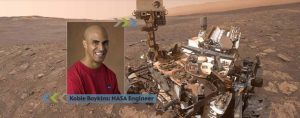NASA engineer who helped build Mars rovers chats about the next challenge
March 18th, 2024 by Ric Hanson
(Radio Iowa) – A Midwestern kid who loved “Star Trek” grew up to be a principal mechanical engineer for NASA who’s worked on every Mars mission since Pathfinder, which took the first rover to the Red Planet in 1996. Kobie Boykins will be in central Iowa this week to tell his personal story, and to discuss the next big project for NASA’s Jet Propulsion Laboratory, in a lecture he’s calling: “Beyond Earth: The Quest for Life on an Icy Moon.”

Graphic provided by Des Moines Performing Arts
“A mission that we’re going to launch later this year called Europa Clipper, to Jupiter, and while we’re at Jupiter, we’re going to be exploring the icy moon of Jupiter called Europa,” Boykins says. “Mostly, we’re going to be talking about the engineering that went into building this vehicle, some of the decisions that went on, and talk about some of the problems and how we fixed them.” As a boy in Omaha, Boykins says he used to sit on his rooftop and gaze up at the stars. He adored “Star Trek: The Next Generation,” particularly the character Geordi La Forge, chief engineer on the starship, Enterprise. Boykins says he always wanted to be the person who was asked to fix things.
“I thought it was very interesting to figure out how things work and then be asked, ‘Hey, how does that work and what would you do? How would you make it better? How would you build that?'” Boykins says. “I think it was probably in fifth grade where I had a teacher that sort of connected with me in some way — magic, I don’t know — that put me on a path to say, ‘Hey, you could be whatever you want,’ and at that time, I wanted to be Geordi La Forge.” In addition to the Pathfinder mission, Kobie designed the solar arrays that powered the Mars rovers Spirit and Opportunity. He also helped build the seven-foot-tall rover Curiosity, which carried 10 different tools, 17 cameras and a laser. While placing robotic rovers on the Martian surface is a tremendous accomplishment, many others (including a few billionaires) are focused on landing -humans- on that dusty red planet, 140-million miles away. Does he see that happening anytime soon?
“We have the technology to send a human being to Mars today. The bigger problem is that the technology is not there to make sure that the human beings stay alive. That’s part of the struggle,” Boykins says. “Will it happen within the next decade or the next two? I think that’s approximately the scale that we’re talking about.” Boykins is chief engineer on NASA’s Europa Clipper mission, and he’s been awarded NASA’s Exceptional Service Medal, one of the highest honors given to NASA employees and contractors. Still, after all his successes with rovers on Mars, Boykins says his biggest thrill is when he learns he’s inspired someone else.
“That’s sort of the legacy for me,” Boykins says, “that I have people that were students or individuals that were looking for what their career might be, and they heard me give a talk about how much I love being able to do this work and this job and they decided, ‘Yeah, this is the path I want to be on,’ and they ended up in the same path, or in the same place that I am. Those are amazing stories to me.” Boykins will appear Thursday as part of the Explorer Series at the Des Moines Civic Center.
On the web at DMPA.org





